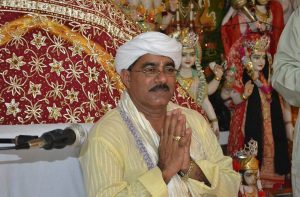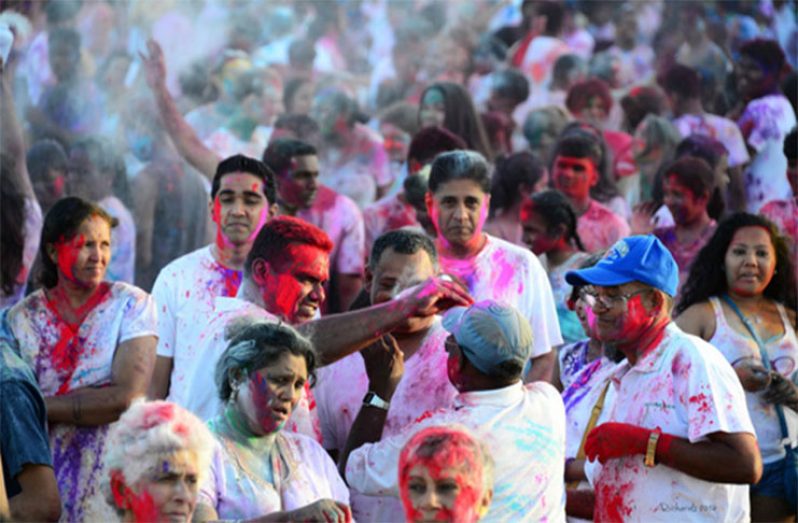BORN out of a story rooted in unshakable belief in God, Holi or Phagwah is an ancient Hindu festival that celebrates the triumph of good over evil.
The story of the colourful celebration was first introduced here some 179 years ago with the arrival of indentured servants from India to work on the sugar plantation.
It is immortalised in the legend of Prahalad and has been told and re-enacted from generation to generations in homes, places of learning and temples.
It is a story about a despotic King Hiranyakashipu who commanded his subjects to worship him, but was met with obstinate rejection by his son Prahalad.
King Hiranyakashipu angered by the action of his son, ordered that he (Prahalad) and his wicked aunt Holika, who was believed to be immune to fire, sit on a pyre which was set ablaze.
According to legend, Holika was burnt to ashes but young Prahalad, a devotee of Vishnu (The Preserver of the Universe), remained unscathed.
The boy thereafter decreed that his aunt will be remembered ever year, thus the burning of the Holika (pyre made of branches) on the night before Phagwah is celebrated.
From the stories told, King Hiranyakashipu was no ordinary being. He was granted a boon by Brahma (the Creator), after great penance, that he would not be killed by any living or non-living creature created by him (Brahma); will not die within or outside his residence during the day or night, on the ground or in the sky, or by any weapon; and have no worthy rival in the battlefield.
These powers blinded King Hiranyakashipu to humanity and made him into a tyrant who later believed that there is no God but himself, forcing the Lord to advent himself to restore his authority.
Mindful of the boon granted to the king, Lord Vishnu came in the form of a half-man, half-lion and paid him a visit he would not live to tell.
KILLED
Abiding by the boon granted by Brahma, Lord Vishnu visited the demonic king at twilight (which is neither day nor night); on the verge of his courtyard (which is neither indoors nor out); and put the king on his thighs (which is neither earth nor space). And using his nails (neither animate nor inanimate) as weapons, he gutted the demon king; bringing an end to his tyranny.

It is in this light that Phagwah is the celebration of triumph of good over evil.
Speaking on this great epic, Pandit Rabindranath Persaud of the Virat Sabha pointed out that freedom is a product of Truth and God which could only be achieved through a process which demands great selfless sacrifice.
“It is impossible to achieve liberation without subscribing to the ultimate truth. The truth is we celebrate the multitudes of differences that add to nature’s beauty. Everyone of God’s creation is distinctively different from each other but yet cohesively contributes to the rich beauty of the universe. This fact should never be ignored. To ignore this fact is to undermine the real significance of the festival. Phagwah is a time to reflect on the unscathed attribute of the truth. Bhakt Prahalad still remains a symbol of truth and dedicated devotion to God. The burning of Holika is a true demonstration that truth needs no support, it stands by itself.”
The story of Prahalad, though the most popular in Guyana, is not the only legend associated with the Spring Festival.
Another version tells of the enduring love between the dark skinned Lord Krishna playfully applying colour to the face of the fair and beautiful Radha.
The central ritual of Holi is the drenching of friends and family with water and applying coloured powder on them, thus the name “Festival of Colours.”
It is also a celebration of the coming of Spring with all its beautiful colours and vibrant life.
ALL EMBRACING CELEBRATION
On Phagwah Day, Guyana also erupts in a colourful spectacle as persons of all ethnic groups be it from Skeldon, Berbice; Albouystown, Georgetown; or Anna Regina, Essequibo Coast, join in the colourful celebrations.
They do so in moving water trucks, water carts or by joining bucket brigades parading on roads and the streets, trying to drench all in their path.
The children who cannot fetch a bucket, are equipped with water guns and those who are not playing, move around villages in bands singing Chowtaals (religious songs).
In some places, the celebrations are so crazy that celebrants assume temporary complexions of red, yellow, green and other colours, for the day. Stained roads and streets are evidence of the boisterous celebrations.
It is a kaleidoscope to behold and day of great sweetmeats from gulaab jamoon, gojha and gul-gula to pholourie.
Of Guyana’s 747,000 people, some 39 per cent are East Indians and 28 per cent of them are Hindus. Only Nepal (81 per cent), India (79 per cent), Mauritius (48 per cent) and Fiji (30 per cent) according to the US State Department and CIA World Factbook have a higher per cent of Indian population.
This year’s Phagwah celebrations are happening at a time when Guyana is celebrating 100 year of abolition of Indian Indentureship, and Prime Minister, Moses Nagamootoo, has hailed the achievement as a triumph of good over evil.
“The ending of that system of exploitation of cheap labour, is indeed a triumph of good over evil. We are forever indebted to our Indian ancestors for preserving, against great odds, their religion, their rituals and their festivities, such as Phagwah, and Diwali, Mother Kali Puja and Yesu Kathas, Eid-ul-Adha, Youman Nabi, as well as other Christian ceremonies.”



.jpg)











